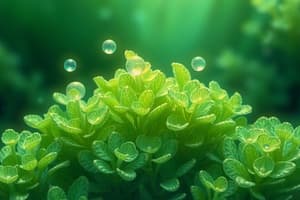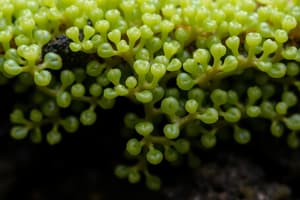Podcast
Questions and Answers
Which pigment primarily gives red algae their characteristic color?
Which pigment primarily gives red algae their characteristic color?
- Phycocyanin
- Carotenoids
- Phycoerythrin (correct)
- Chlorophyll
What type of starch is primarily accumulated in the cells of red algae during photosynthesis?
What type of starch is primarily accumulated in the cells of red algae during photosynthesis?
- Floridean starch (correct)
- Lucosaccharose
- Glycogen
- Amylose
What is the primary structure of the cell walls in diatoms made of?
What is the primary structure of the cell walls in diatoms made of?
- Chitin
- Silica (correct)
- Calcium carbonate
- Cellulose
Which characteristic is NOT associated with members of the Rhodophyta?
Which characteristic is NOT associated with members of the Rhodophyta?
What is the maximum known depth at which red algae can grow?
What is the maximum known depth at which red algae can grow?
Which of the following best describes the reproductive method of red algae?
Which of the following best describes the reproductive method of red algae?
What shape can red algae display?
What shape can red algae display?
What is a significant feature of diatom reproduction?
What is a significant feature of diatom reproduction?
What distinctive feature do the cell walls of diatoms have?
What distinctive feature do the cell walls of diatoms have?
Where are diatoms commonly found?
Where are diatoms commonly found?
What characterizes the chloroplasts in Chlorophyta?
What characterizes the chloroplasts in Chlorophyta?
Which of the following statements about the reproduction of Chlorophyta is accurate?
Which of the following statements about the reproduction of Chlorophyta is accurate?
Which type of cell organization is found in coenocytic Chlorophyta?
Which type of cell organization is found in coenocytic Chlorophyta?
What types of organisms do chlorophytes belong to based on their motility?
What types of organisms do chlorophytes belong to based on their motility?
Which of the following characteristics is NOT typical of Chlorophyta?
Which of the following characteristics is NOT typical of Chlorophyta?
In many higher forms of Chlorophyta, where are flagella typically found?
In many higher forms of Chlorophyta, where are flagella typically found?
Which type of spore does NOT represent an asexual reproduction method in Chlorophyta?
Which type of spore does NOT represent an asexual reproduction method in Chlorophyta?
Which terms describe the modes of sexual reproduction in Chlorophyta?
Which terms describe the modes of sexual reproduction in Chlorophyta?
What unique feature characterizes heterocysts in cyanophyta?
What unique feature characterizes heterocysts in cyanophyta?
Which of the following accurately describes the reproductive method of cyanophyta?
Which of the following accurately describes the reproductive method of cyanophyta?
What components make up the cell wall of cyanophytes?
What components make up the cell wall of cyanophytes?
What are akinetes primarily responsible for in cyanophyta?
What are akinetes primarily responsible for in cyanophyta?
Which of the following is true regarding the characteristics of Nostoc?
Which of the following is true regarding the characteristics of Nostoc?
What distinguishes Anabaena from other cyanophytes?
What distinguishes Anabaena from other cyanophytes?
Which statement accurately describes the pigment composition in cyanophyta?
Which statement accurately describes the pigment composition in cyanophyta?
What is the nature of the protoplast in cyanophytes?
What is the nature of the protoplast in cyanophytes?
In regards to their habitat, where are cyanophytes most commonly found?
In regards to their habitat, where are cyanophytes most commonly found?
What role do chromoplasmic zones have in cyanophytes?
What role do chromoplasmic zones have in cyanophytes?
Flashcards are hidden until you start studying
Study Notes
Eukaryotic Algae Overview
- Eukaryotic algae are classified into various divisions, including Chlorophyta (green algae), Cyanophyta (blue-green algae), Rhodophyta (red algae), and Bacillariophyta (diatoms).
Division Chlorophyta (Green Algae)
- Presence of chlorophyll in plastids (chloroplasts).
- Mostly freshwater species; some are terrestrial.
- Forms can be unicellular, colonial (motile or non-motile), multicellular (thalloid or filamentous), or coenocytic.
- Protoplast is organized with a definite nucleus and distinct chloroplasts, often containing pyrenoids.
- Cell walls are composed of cellulose with pectose layers; some have gelatinous sheaths.
- Motility in unicellular/colonial forms is facilitated by flagella or cilia, usually in pairs, occasionally in larger numbers.
- Higher forms have flagella exclusive to reproductive structures (zoospores and zoogametes).
- Reproduction methods include:
- Vegetative: cell division or fragmentation.
- Asexual: via motile zoospores, non-motile aplanospores, or akinetes.
- Sexual: can be isogamous, anisogamous, or oogamous, with some species being homothallic.
Division Cyanophyta (Blue-Green Algae)
- Characterized by blue-green pigment phycocyanin and chlorophyll.
- Primarily unicellular; some form chains or colonies.
- Found in freshwater, often in stagnant water and wet ground.
- Cell structure is primitive without a definite nucleus; protoplast has chromoplasm (peripheral colored zone) and a central body.
- Cell walls made of cellulose and pectic compounds; starch absent, glycogen present.
- Common vegetative reproduction methods include cell division, colony fragmentation, and hormogonia formation.
- Lack sexual reproduction and ciliated bodies.
- Resting spores (akinete) develop in some filamentous forms, and heterocysts are specialized for nitrogen fixation.
Division Rhodophyta (Red Algae)
- Composed of specialized marine algae, widely distributed in temperate and tropical seas.
- Found at various depths, with many species attached to rocky substrates.
- Possess red pigment phycoerythrin, which masks chlorophyll, and some contain phycocyanin.
- Forms can be filamentous, ribbon-shaped, or leaf-like; lengths range from a few centimeters to over a meter.
- Accumulate floridean starch as a product of photosynthesis; motile reproductive cells and zoospores are absent.
- Members may be haploid or alternate between haploid and diploid stages, as seen in Polysiphonia.
Division Bacillariophyta (Diatoms)
- Known for their beautiful, unicellular forms; occasionally form filaments and colonies.
- Widely distributed in freshwater and saltwater, as well as wet ground.
- Form significant populations in oceans, notably as plankton.
- Composed of silica with cell walls that consist of two overlapping halves (epitheca and hypotheca).
- Fossil diatoms contribute to deposits of diatomaceous earth, essential for various industrial applications.
Studying That Suits You
Use AI to generate personalized quizzes and flashcards to suit your learning preferences.




